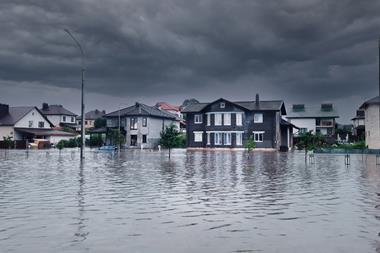Tackling property resilience following flooding presents ‘a lot of opportunity’ for insurance industry this year, while digital tools target ‘hyper-convenience’, notes Zurich’s UK chief claims officer
As the insurance industry heads more firmly into 2022, supply chain challenges and the associated property claims inflation, as well as the positive use of digital support tools at insurance firms, will continue to impact the claims sector, according to David Nichols, UK chief claims officer at insurer Zurich.
Speaking exclusively to Insurance Times, Nichols explains that “something all insurers are pretty much experiencing at the moment is property supply chain challenges around both materials, skills and the fact that neither of those things are quite where they used to be”.
In turn, this affects “the timeline attached to some property repairs” and presents “a knock-on cost consideration in terms of claims inflation”.
“Inflation comes through in the fact that we’ll be slower to repair some of the properties if the materials don’t exist or the skills aren’t available on the ground to get them done,” Nichols adds. “There’s still a real overdemand versus capacity.”

Although this trend is, in part, driven by the Covid-19 pandemic and the various global lockdown restrictions, Nichols notes that Brexit is also to blame.
He says: “It’s a mixture of Brexit and [the] pandemic, but splitting the two is almost impossible because they’ve happened together, so you’re feeling the consequences of both at the same time.”
Flood resilience opportunities
Despite these supply chain struggles, Nichols is “particularly excited” about tackling flooding risks in 2022, as well as further embracing the ‘Build Back Better’ scheme, which was initially launched by joint government and insurance initiative Flood Re in 2019.
This approach aims to utilise the property repair process following flood damage to make buildings more resilience, striving to reduce both the cost and impact of future flooding.
This could include, for example, the implementation of property flood resilience (PFR) measures, such as self-closing air bricks, non-return valves and flood doors or barriers.
“There’s a lot of opportunity to make properties more resilient following a flood and I like that opportunity actually,” Nichols says. “I just love the idea of making a customer’s home more resilient to flood in the future.
“It goes beyond the bricks and mortar piece because insurance is there to make sure that the property is reinstated - that’s fine, but what insurance can’t do is replace all of those really emotional things that often get completely destroyed in a flood.
“If as an industry, we can make all properties more resilient, I just think that’s a wonderful thing for us to be able to do.”
Zurich has already undertaken a number of projects to action this mindset ahead of 2022, including launching its Flood Resilience Toolkit in November 2021.
Nichols adds that the insurer is also building close relationships with the Department for Environment, Food and Rural Affairs (Defra) and public body the Environment Agency to further explore Build Back Better concepts, including flood mapping, sustainable drainage systems, new build requirements and planning permissions.
“There’s just an awful lot in there that can be done to both build with a more resilient mind and to reinstate,” Nichols continues.
Zurich even conducted a session at the end of last year “with the London mayoral office around the recent flash flooding in London”, to improve government understanding of Build Back Better.
“It would be really great to see more understanding [on property resilience] across the board, not just at the claims stage,” Nichols says. “[Zurich is having] some really good dialogue with people that I can see are really interested in making resilience a reality.”

Creating ‘hyper-convenience’
A further “brilliant” claims trend that Nichols believes is “continuing at pace” is the “whole host of digital solutions that have sprung up during lockdown”.
He says that many of these technology developments – such as remote inspection tools, claims tracking for customers, the ability for brokers to review their portfolio of claims, straight-through claims processing and “game-changer” artificial intelligence that validates claims, coverage and documents – centre around facilitating “hyper-convenience” and building “really exciting capability that is designed to speed up our claims settlement journey”.
He continues: “The innovation that’s coming through just to make the customer’s life simpler and easier is utterly brilliant, it really is.
“That for me is just such a major win from a customer point of view. It’s a win-win because the longer you have a claim file open, the more expensive it’s going to be and the more disappointed the customer will be. So, being able to do it upfront is just a no-brainer, it really is.
“There’s definitely a positive trend around digital engagement, digital support tools – I think that’s just going to continue to accelerate because it’s been really eye-opening how much we’ve been able to get done during a lockdown environment and I think that will absolutely continue.
“I’m certainly not taking my foot off the accelerator pedal when it comes to our own digital products journey because I see such a lot of positive customer benefit - just being able to track and monitor, to have the support of people in the journey when you need people to talk to, but also having the flexibility of a digital platform to manage the day-to-day entity of successfully concluding a claim.”
Hosted by comedian and actor Tom Allen, 34 Gold, 23 Silver and 22 Bronze awards were handed out across an amazing 34 categories recognising brilliance and innovation right across the breadth of UK general insurance.





















































No comments yet